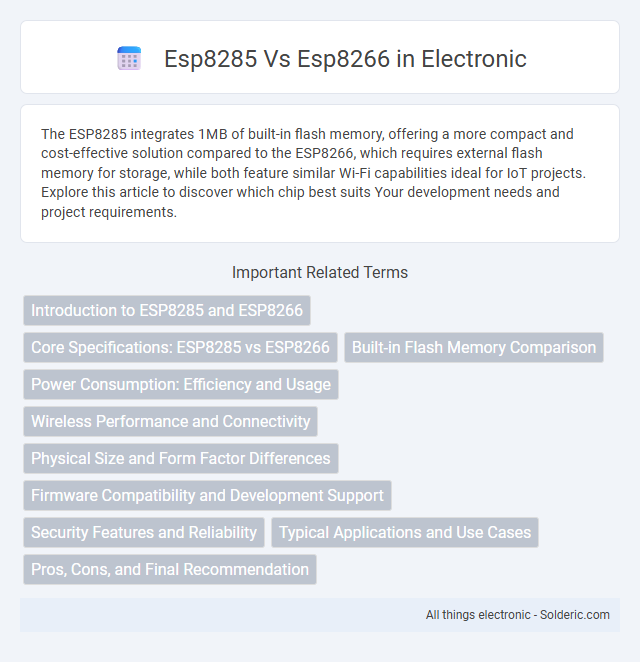The ESP8285 integrates 1MB of built-in flash memory, offering a more compact and cost-effective solution compared to the ESP8266, which requires external flash memory for storage, while both feature similar Wi-Fi capabilities ideal for IoT projects. Explore this article to discover which chip best suits Your development needs and project requirements.
Comparison Table
| Feature | ESP8285 | ESP8266 |
|---|---|---|
| Microcontroller | 32-bit Tensilica L106 | 32-bit Tensilica L106 |
| Clock Speed | 80 MHz / 160 MHz | 80 MHz / 160 MHz |
| Flash Memory | Integrated 1MB Flash | External Flash (up to 16MB) |
| Wi-Fi | 802.11 b/g/n | 802.11 b/g/n |
| GPIO Pins | Up to 17 | Up to 17 |
| Price | Typically higher due to embedded flash | Generally lower |
| Use Case | Compact designs needing onboard flash | Flexible flash options for various needs |
| Power Consumption | Low power modes supported | Low power modes supported |
Introduction to ESP8285 and ESP8266
The ESP8285 and ESP8266 are popular Wi-Fi modules developed by Espressif Systems, used widely in IoT applications for their compact size and low power consumption. Both chips feature a Tensilica Xtensa 32-bit LX106 microcontroller with integrated Wi-Fi, but the ESP8285 includes 1MB of built-in flash memory, unlike the ESP8266 which requires an external flash chip. Your choice between the two depends on project size constraints and memory needs, with the ESP8285 offering a more integrated solution.
Core Specifications: ESP8285 vs ESP8266
The ESP8285 and ESP8266 both feature a Tensilica Xtensa 32-bit LX106 core, running at up to 80 MHz, with the primary difference being the ESP8285's integrated 1MB flash memory compared to the ESP8266's external flash requirement, enhancing compactness and design simplicity. Both chips offer similar Wi-Fi capabilities supporting 802.11 b/g/n standards and possess comparable RAM sizes of approximately 50 KB for instruction cache and 96 KB for data. Power consumption levels are alike, but the ESP8285's built-in flash memory reduces external component count, making it suitable for more integrated IoT applications.
Built-in Flash Memory Comparison
The ESP8285 features 1MB of built-in flash memory integrated directly on the chip, providing a compact, space-saving solution ideal for smaller projects. In contrast, the ESP8266 relies on external flash memory, which offers more flexibility with memory sizes but requires additional components and PCB space. Choosing the ESP8285 can simplify your design by reducing external parts, while the ESP8266 allows customization of flash capacity for more demanding applications.
Power Consumption: Efficiency and Usage
The ESP8285 integrates a built-in 1MB flash memory, offering similar power consumption to the ESP8266 but with enhanced efficiency due to its smaller package and lower current consumption in deep sleep mode, typically around 20uA compared to the ESP8266's 70uA. Your projects benefit from longer battery life when choosing the ESP8285 for energy-sensitive applications, especially in IoT devices requiring prolonged standby periods. Both modules support various power-saving modes, but the ESP8285's optimized design makes it more suitable for ultra-low-power usage scenarios.
Wireless Performance and Connectivity
The ESP8285 features an integrated 1MB flash memory, improving onboard storage without compromising the wireless connectivity found in the ESP8266. Both modules operate on the 2.4 GHz Wi-Fi band, supporting 802.11 b/g/n protocols, but the ESP8285 offers slightly enhanced power efficiency for prolonged wireless operation. Wireless performance in both chips delivers reliable signal strength and stable connectivity for IoT applications, with the ESP8285 providing incremental improvements in integrated system design and energy consumption.
Physical Size and Form Factor Differences
The ESP8285 features a compact 5x5mm package compared to the slightly larger 5x5.5mm ESP8266, making the ESP8285 more suitable for space-constrained applications. Both modules share a similar pin configuration but the ESP8285 integrates 1MB of flash memory on-chip, reducing the need for external components and overall board size. This physical size advantage of the ESP8285 supports more streamlined designs in IoT devices where reducing PCB footprint is critical.
Firmware Compatibility and Development Support
ESP8285 and ESP8266 share high firmware compatibility due to their similar architecture and use of the same ESP8266 core SDK, enabling developers to easily port code and utilize existing libraries across both modules. Development support for ESP8266 is more extensive, with a larger community, more tutorials, and broader tool ecosystem, while ESP8285, featuring integrated 1MB flash memory, is gaining traction for compact IoT applications without compromising firmware flexibility. Both modules support popular development platforms like Arduino IDE and Espressif's ESP-IDF, ensuring robust environments for firmware customization and application development.
Security Features and Reliability
The ESP8285 offers enhanced security features compared to the ESP8266, including integrated flash memory that reduces external attack surfaces and supports secure boot and hardware encryption. Both chips provide reliable Wi-Fi connectivity, but the ESP8285's built-in 1MB flash improves stability by minimizing dependencies on external components. These enhancements make the ESP8285 more suitable for secure and dependable IoT applications where data protection and consistent performance are critical.
Typical Applications and Use Cases
The ESP8285 is ideal for compact IoT devices requiring built-in flash memory, such as smart home sensors and wearable electronics, due to its integrated 1MB flash reducing board size. The ESP8266 is commonly used in DIY projects, home automation, and Wi-Fi-enabled devices where external flash memory allows for flexibility and higher storage capacity. Both chips excel in wireless communication applications, but the ESP8285 suits space-constrained designs while the ESP8266 supports more complex firmware.
Pros, Cons, and Final Recommendation
The ESP8285 offers a significant advantage over the ESP8266 by integrating 1MB of built-in flash memory, reducing the need for external components and enabling more compact and cost-effective designs. While the ESP8266 provides more memory options and is widely supported with a larger community, it requires external flash, which can increase board size and complexity. For projects prioritizing compactness and simplified hardware, the ESP8285 is recommended, whereas the ESP8266 is better suited for applications demanding flexible memory configurations and broader development resources.
esp8285 vs esp8266 Infographic

 solderic.com
solderic.com